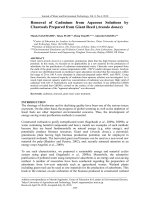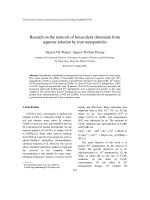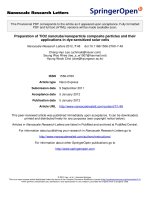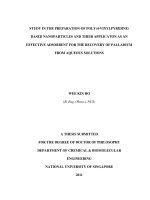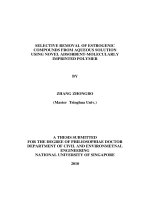Preparation of chitosan magnetite composite beads and their application for removal of Pb(II) and Ni(II) from aqueous solution
Bạn đang xem bản rút gọn của tài liệu. Xem và tải ngay bản đầy đủ của tài liệu tại đây (914.32 KB, 7 trang )
Preparation of chitosan/magnetite composite beads and their application for removal
of Pb(II) and Ni(II) from aqueous solution
Hoang Vinh Tran
a
, Lam Dai Tran
b,
⁎
, Thinh Ngoc Nguyen
a
a
Faculty of Chemical Technology, Hanoi University of Technology, 1, Dai Co Viet Road Hanoi, Vietnam
b
Institute of Materials Science, Vietnamese Academy of Science and Technology, 18, Hoang Quoc Viet Road, Hanoi, Vietnam
abstractarticle info
Article history:
Received 7 September 2009
Received in revised form 15 October 2009
Accepted 12 November 2009
Available online 20 November 2009
Keywords:
Fe
3
O
4
nanoparticles
Chitosan/magnetite composite beads
Adsorption isotherm
Pb and Ni(II)
A simple and effective process has been proposed to prepare chitosan/magnetite nanocomposite beads with
saturation magnetization value as high as uncoated Fe
3
O
4
nanoparticles (ca. 54 emu/g). The reason was that
the coating chitosan layer was so thin that it did not affect magnetic properties of these composite beads.
Especially, chitosan on the surface of the magnetic Fe
3
O
4
nanoparticles is available for coordinating with
heavy metal ions, making those ions removed with the assistance of external magnets. Maximum adsorption
capacities for Pb(II) and Ni(II), occurred at pH 6 and under room temperature were as high as 63.33 and
52.55 mg/g respectively, according to Langmuir isotherm model. These results permitted to conclude that
chitosan/magnetite nanocomposite bea ds could serve as a promising adsorbent not only for Pb(II) and Ni(II)
(pH=4–6) but also for other heavy metal ions in wastewater treatment technology.
© 2009 Elsevier B.V. All rights reserved.
1. Introduction
Along with the technological progresses, toxic metal contamina-
tion becomes a serious problem threatening human health. Heavy
metal ions such as Pb(II), Cd(II), Hg(II), and Ni(II) are toxic and
carcinogenic at relatively low concentrations. They are not self-
degradable and can accumulate in living organisms, causing severe
disorders and diseases. In order to remove heavy metal ions from
various environments, the techniques such as precipitation, adsorp-
tion, ion exchange, reverse osmosis, electrochemical treatments,
membrane separation, evaporation, coagulation, flotation, oxidation
and biosorption processes are widely used [1–10]. These conventional
techniques are costly and have significant disadvantages such as
generation of metal bearing sludge or wastes, incomplete metal
removal, and the disposal of secondary wastes. For these reasons,
there is a need for developing economic and eco-friendly methods for
wastewater treatments. Adsorption is an attractive process, in view of
its efficiency and the ability to treat wastewater containing heavy
metals. Over the last few decades adsorption has gained importance
as an effective purifi ca tion and separation technique used in
wastewater treatment and low cost adsorbents are becoming the
focus of many investigations on the removal of heavy metals from
aqueous solutions [11–15].
Chitosan has excellent properties for the adsorption of metal ions,
principally due to the presence of amino groups (–NH
2
) in the
polymer matrix, which can interact with metal ions in solution by ion
exchange and complexation reactions [11]. The high content of amino
groups also makes possible many chemical modifications in polymer
with the purpose of improving selectivity and adsorption capacity.
In this paper, chitosan/magnetite nanocomposite beads were
prepared, characterized and used for removal of toxic metal ions
such as Pb(II), Ni(II) in the pH range from 4 to 6. Langmuir isotherms
were used to analyze the equilibrium data at different pH. These
nanocomposite beads can be removed easily from water with the help
of an external magnet thanks to their exceptional magnetic
properties.
2. Experimental
2.1. Chemicals
All reagents were analytical grade and used as received without
further purification. F eSO
4
·7H
2
O, FeCl
3
·6H
2
O, Pb(CH
3
COO)
2
or
NiSO
4
·7H
2
O, 4-(2-pyridylazo)rezocxin and Ni(II)-dimetyl glyoxim
were purchased from Merck. NH
4
OH 25 wt.%, NaOH, CH
3
COOH and
Br
2
were purchased from Duc Giang Chemical Company (Vietnam).
Chitosan (MW=400,000, DA=70%) was purchased from Nha Trang
Aquatic Institute (Vietnam) and re-characterized by viscometry and
IR measurements at our laboratory [16].
2.2. Synthesis of chitosan/magnetite composite beads
Chitosan/magnetite composite beads were prepared by chemical
co-precipitation of Fe
2+
and Fe
3+
ions by NaOH in the presence of
chitosan followed by hydrothermal treatment [17].Briefly, the
solution of chitosan, prepared with 0.5 g of chitosan was dissolved
Materials Science and Engineering C 30 (2010) 304–310
⁎ Corresponding author. Tel.: +84 4 37564129; fax: +84 438360705.
E-mail address: (L.D. Tran).
0928-4931/$ – see front matter © 2009 Elsevier B.V. All rights reserved.
doi:10.1016/j.msec.2009.11.008
Contents lists available at ScienceDirect
Materials Science and Engineering C
journal homepage: www.elsevier.com/locate/msec
into 5 ml of CH
3
COOH (99.5 wt.%, d =1.05 g/ml) and 45 ml of distilled
water (pH=2–3), FeCl
2
and FeCl
3
were dissolved in 1:2 molar ratio
and then the resulting solutionwas dropped slowly into NaOH 30 wt.%
solution to obtain chitosan/magnetite beads with different mass ratios
of chitosan/magnetite: 0/1 (pure Fe
3
O
4
); 1/2 and 4/1. The suspension
was kept at room temperature for 24 h without stirring and separated
by washing several times in water to remove alkaline. The particles
were finally dried in vacuum at 70 °C for 24 h to obtain chitosan/
magnetite composite beads as adsorbent.
2.3. Characterization methods
X-ray Diffraction (XRD) patterns were obtained at room temper-
ature by D8Advance, Bruker ASX,using CuKα radiation (λ =1.5406 Å)
in the range of 2θ=10°–60°, and a scanning rate of 0.02 s
− 1
. Infra red
(IR) spectra were recorded with Nicolet 6700 FTIR Spectrometer,
using KBr pellets, in the region of 400–4000 cm
− 1
, with resolution of
4cm
− 1
. Morphology of composites was analyzed by Field Emission
Hitachi S-4500 Scanning Elect ron Microscope (FE-SEM) and Trans-
mission Electron Microscope (TEM, JEOL, Voltage: 100 kV, magnifi-
cation: ×200,000). A bsorbance measurements were carried out on
UV–vis Agilent 8453 spectrophotometer in the range of 400–800 nm.
The magnetic properties were measured with homemade vibrating
sample magnetometer ( VSM) an d evaluated in terms of s aturation
mag netization and coercivity. Chemical composition of samples was
determined by JEOL Scanning Electron Microscope and Energy
Dispersive X-ray (SEM/EDS) JSM-5410 Spectrometer.
2.4. Adsorption studies
Chitosan/magnetite nanocomposite beads were used as magnetic
adsorbents for the adsorption of Ni(II) and Pb(II). The adsorption
behaviors of Pb(II) and Ni(II) ions were investigated in aqueous
solutions at pH 4–6 and at room temperature as follows: 0.01 g
chitosan/magnetite composite beads were added to 100 ml of Pb
(CH
3
COO)
2
or NiSO
4
solution respectively with initial concentrations
(C
0
) varied from 50 to 80 mg/l for 120 min (contact time). The
concentration of Pb(II) and Ni(II) ions was determined by spectro-
photometric assay and the procedure is as follows: 1 ml of sample
solution was mixed with 4-(2-pyridylazo)rezocxin (PAR), sodium
acetate, NH
3
at pH=10. After the formation of the Pb(II)-4-(2-
pyridylazo)rezocxin complex, the concentration of Pb(II) ions was
determined fro m the absorbance peak at 530 nm on a UV–vis
spectrophotometer. To determine concentration Ni(II) ions, 1 ml of
sample solution was mixed with sodium dimetyl glyoxim 1.2 wt.%,
sodium hydroxide solution and Br
2
solution. After the formation of the
Ni(II)-dimetyl glyoxim complex, the concentration of Ni(II) ions was
determined from the absorbance at 475 nm. The amount of Pb(II) and
Ni(II) uptake was calculated as % recovery=C
0
− C
e
/C
0
, where C
0
and
C
e
represented initial and equilibrium concentrations of metal ions in
aqueous solution respectively.
3. Results and discussion
3.1. Characterization of chitosan/magnetite composite beads
3.1.1. Morphology and particles of chitosan/magnetite composite beads
Balancing between high adsorption capacity (due to chitosan) and
magnetic properties (due to Fe
3
O
4
) various molar ratios of chitosan/
Fe
3
O
4
were investigated. In our study, mass ratio of CS/Fe
3
O
4
of 4/1
seems to be an appropriate value (see Section 3.1.4 (Magnetic
properties) and Section 3.2.1 (Isotherm adsorption study)). Fig. 1a
and b shows the digital camera picture and SEM image respectively of
chitosan/magnetite composite beads with CS/Fe
3
O
4
ratio of 4/1. Being
spherical in form, solid in structure and quite big in size, CS/Fe
3
O
4
beads (microspheres) are more applicable for removal of heavy
metals ion in solution with external magnets, and easily recyclable
than CS-free, separated Fe
3
O
4
particles.
3.1.2. XRD analysis
Fig. 2 showed XRD patterns of pure Fe
3
O
4
(i) and chitosan/
magnetite composite beads (lines (ii) and (iii)). Six characteristic
peaks for Fe
3
O
4
corresponding to (220), (311), (400), (422), (511)
and (440) were observed in all samples (JCPDS file, PDF No. 65-3107).
Quite weak diffraction lines of composite patterns indicated that
Fig. 1. a. Digital camera picture of chitosan/magnetite composite beads. b. SEM image of
chitosan/magnetite composite beads (CS/Fe
3
O
4
=4/1).
Fig. 2. XRD pattern of Fe
3
O
4
and composite beads (CS/Fe
3
O
4
=1/2; 4/1).
305H.V. Tran et al. / Materials Science and Engineering C 30 (2010) 304–310
Fe
3
O
4
particles have been coated by amorphous chitosan. Further-
more, this coating did not result in phase change of Fe
3
O
4
. Line
broadening in the pattern can be quantitatively evaluated using
Debye–Scherrer equation d=(kλ/βcos θ), which gives a relationship
between peak broadening in XRD and particle size. In this equation d
is the thickness of the crystal, k is the Debye–Scherrer constant (0.89),
λ is the X-ray wavelength (0.15406 nm) and β is the line broadening
in radian obtained from the full width at half maximum, θ is the Bragg
angle. According to Debye–Scherrer equation, particle sizes of
uncoated Fe
3
O
4
and chitosan-coated Fe
3
O
4
are estimated to be
22 nm and 35 nm respectively. These results are consistent with
those obtained by TEM technique (see below).
3.1.3. TEM image of pure Fe
3
O
4
and chitosan-coated Fe
3
O
4
Typical TEM micrographs for pure Fe
3
O
4
and chitosan-coated
Fe
3
O
4
were demonstrated on Fig. 3. It is clear that pure Fe
3
O
4
nanoparticles were quite agglomerated with mean diameter in the
range of 15–20 nm, while TEM image of chitosan-coated magnetite
nanoparticles was looser, less agglomerated, and bigger in size (25–
30 nm). Moreover, TEM images showed different contrasts of CS–
Fe
3
O
4
beads: the dark areas represent crystalline Fe
3
O
4
while the
bright ones are assigned for amorp hous CS (these areas were
indicated on Fig. 3c by the arrows).
3.1.4. Magnetic properties of chitosan/magnetic composite beads
To test whether the synthesized beads could be used as a magnetic
adsorbent in the magnetic separation processes, magnetic measure-
ments were performed on VSM. Typical magnetization loops were
recorded and shown on Fig. 4. From the plot of magnetization (M),
magnetic field (H) and its e nlargement near the origin, the s aturation
magnetization (M
s
), remanence magnetization ( M
r
), coercivity ( H
c
)and
squareness ( S
r
=M
r
/M
s
) could be calculated. Because of no remanence
and coercivity, it can b e suggested that the beads are s uperparamagnetic.
Another characteristic supporting this identification is that small enough
Fig. 3. TEM images of uncoated Fe
3
O
4
(a) and chitosan-coated Fe
3
O
4
(b,c).
Fig. 4. Magnetic hysteresis curves of Fe
3
O
4
and composite beads (CS/Fe
3
O
4
=1/2; 4/1). Fig. 5. IR spectra of Fe
3
O
4
, CS and composite beads (CS/Fe
3
O
4
=4/1).
306 H.V. Tran et al. / Materials Science and Engineering C 30 (2010) 304–310
particle size made thermal fluctuation (∼ kT, T is temperature) over-
whelmed magnetic anisotropy (∼ kV,V is particle volume). The saturation
magnetization is around 55 emu/g, which is m uch higher than those
reported in literature f or other chitosan based Fe
3
O
4
beads [1 8,19].Itcan
be also observed from this figure that magnetization moment of Fe
3
O
4
nanoparticles decreases very little after chitosan surface coating (M
s
values for the naked Fe
3
O
4
nanoparticles and composite beads with mass
ratio of CS/Fe
3
O
4
of 1/2 and 4/1 are almost the same), this result signifies
that chitosan does not affect magnetic properties of these composite
beads, which can be explained by high coating efficiency by chitosan
(high loading of Fe
3
O
4
core, thin layer of c hitosan shell) on Fe
3
O
4
particles. Therefore, maintaining such a high saturation magnetization
Fig. 6. Schematic formation process of chitosan/magnetite composite beads.
307H.V. Tran et al. / Materials Science and Engineering C 30 (2010) 304–310
value (M
s
) after coating these beads is more advantageous and
susceptible to the external magnetic field for magnetic separation,
compared with those beads obtained by other methods.
3.1.5. IR analysis
To confirm the existence of the surface coating, FTIR spectra of the
pure Fe
3
O
4
(a), chitosan (b) and chitosan/magnetite composite beads
(c) were examined and shown on Fig. 5. For the pure Fe
3
O
4
, the peak
at 605 cm
− 1
is attributed to Fe–O group, the peak around 3420–
3422 cm
− 1
can be related to the –OH group of adsorbed water. IR
spectrum of chitosan is characterized by the following absorption
bands: ν(O–H) appeared at 3395 cm
− 1
, ν(C–H) of backbone polymer:
2915, 2860 cm
− 1
, ν(C
3
–O) of primary alcoholic group: 1409 cm
− 1
,
ν(C–O), amide I at 1091 and 1031 cm
− 1
, δ(N–H), amide II of primary
amine: 3400, 1638 cm
− 1
. By comparison of IR spectra of a, b, c
samples it can be noted that the presence of chitosan did shift IR
vibrations of Fe
3
O
4
but did not alter them very much. Especially, the
band shift of Fe–O stretching (from 610 to 595 cm
− 1
) and that of N–H
bending vibration from 1638 to 1681 cm
− 1
is the most significant.
These data indicated possible binding of iron ions to NH
2
group of
chitosan. Besides, electrostatic interaction between surface negative
charged Fe
3
O
4
and positively protonated chitosan can also contribute
to this IR change. It means that Fe
3
O
4
is coated by chitosan and no
chemical bonding between chitosan and Fe
3
O
4
was formed.
SEM, TEM and IR results are important because they evidenced the
successful coating of Fe
3
O
4
nanoparticles by chitosan and pelletizing
them in magnetic beads with the aid of NaOH. Chitosan on the surface
of the magnetic nanoparticles is available for coordinating with heavy
metal ions, making those ions removed with the assistance of external
magnets. The synthetic procedure of composite beads was schemat-
ically presented in Fig. 6.
3.2. Application of chitosan/magnetite composite beads for removal
Ni(II) and Pb(II) in solution
3.2.1. Isotherm adsorption study
Adsorption isotherm is a functional expression that correlates the
amount of solute adsorbed per unit weight of the adsorbent and the
concentration of an adsorbate in bulk solution at a given temperature
under equilibrium conditions. It is important to establish the appropri-
ate relationship for the batch equilibrium data using empirical or
theoretical equations as it may help in modeling, analyzing and
designing adsorption systems. The adsorption isotherms are one of
the most useful data to understand the mechanism of the adsorption
andthe characteristics of isothermsareneeded beforethe interpretation
of the kinetics of the adsorption process. Many models have been
proposed to explain adsorption equilibrium, however,no general model
has been found to fit the experimental data accurately under any given
condition. Among various plots employed for analyzing the nature of
adsorbate–adsorbent interaction, adsorption isotherms were the most
significant, among which Langmuir and Freundlich isotherms were
most used to describe the equilibrium sorption of metal ions [17,18,20].
Namely, Langmuir adsorption equation has the following form:
C
e
q
e
=
1
q
m
⋅K
L
+
C
e
q
m
ð1Þ
where C
e
is the equilibrium concentration of metal ions (mg/l), q
e
is the
amount of metal ions adsorbed per gr am adsorbent (mg/g), q
m
is the
maximum adsorption of metal ions (mg/g), and K
L
is the Langmuir
adsorption equilibrium constant (l/mg). The plot of C
e
/q vs. C
e
yielded
straight lines. The values of q
m
and K
L
can be calculated from the slope
Fig. 7. Langmuir isotherm of the Ni(II) (a) and Pb(II) (b) adsorption on chitosan/
magnetic composite beads (CS/Fe
3
O
4
=4/1).
Table 1
Langmuir isotherm parameters for the adsorption of Pb(II) and Ni(II) ions on magnetic
chitosan/adsorbents at room temperature.
pH Pb(II) Ni(II)
K
L
q
max
(mg/g
–1
)
R
2
%
recovery
K
L
q
max
(mg/g
–1
)
R
2
%
recovery
4 0.01845 49.55 0.971 70.79 0.2974 21.19 0.986 30.27
5 0.02027 54.80 0.999 78.29 0.5939 23.30 0.977 33.29
6 0.10973 63.33 0.982 90.47 1.3448 52.55 0.977 75.07
Table 2
Comparison of metals ion adsorption capacities at different adsorbents.
No. Adsorbent Metals pH T
(K)
q
max
(mg/g
–1
)
Ref.
1 Chitosan functionalized with 2[-bis-
(pyridylmethyl)aminomethyl]-4-
methyl-6-formylphenol
Ni(II) 3 – 9.6 [2]
2 Magnetic Co
3
O
4
-containing resin Ni(II) 7.8 – 75.71 [5]
3 Tobacco stem Pb(II) 5 299 5.5435 [12]
4 Magnetic-poly-2-acrylamido-2-methyl-
1-propansulfonic acid p(AMPS)
hydrogels
Ni(II) –– 114.94 [15]
Pb(II) –– 140.84
5 Chitosan-coated perlite beads Ni(II) 5 298 56.18 [17]
6 Meranti sawdust Ni(II) 303 35.971 [19]
Pb(II) 303 34.246
308 H.V. Tran et al. / Materials Science and Engineering C 30 (2010) 304–310
and i ntercept respectively. T he results of adsorption studies of Ni(II) and
Pb(II) w iththe fitted Lang muir e quations at d ifferent concentrations ofNi
(II) and Pb(II) for pH=4–6onafixed amount of adsorbent were
presented on Fig. 7 and summarized on Table 1.pHselectionintherange
of 4–6 was rationalized by the fact that chitosan could be dissolved with
pHb 3; while p HN 7 could result in the formation of metal hydroxide
precipitates .
From Table 1 it can be see n that pH solut ion w as an important
variable, because it controls the adsorption of the metals on the
solid–water interfaces. The pH affects the availability of Pb, Ni ions in
solution and the metal binding sites of the a dsorbent. It can be noted
that t here was an increase in metal uptake along with a n increase in
pH up to 6. Pb(II) was more stron gly attracted to the adsorben t than
Ni(II), with higher removal percentage than Ni(II) at the same pH.
Moreover, according to Table 2, adsorption capacity of synthesized
chi tosan/magnetite beads was at least comparable and even hi gher
to that of other chitosan based adsorbents for both Ni(II) and Pb( II),
exc ept for hydrogels of 2- acrylamido-2-methyl-1-propansulfonic
acid (AMPS) [11,21–25], thanks to hydrogel cross-linking between
chitosan matrix and magnetic particles of the later, which made it
technically more attractive for removal of pollutants, but econom-
ica lly less competitive compared to our composite beads. T he per-
centage of ion recovery (noted as % r recovery) depends on the initial
concentration C
0
and decreases with C
0
.AscanbeseenfromTable 1,
maximum adsorption capac ities q
max
are 63.33 and 52.55 mg/g and
percentages of ion recovery % r are 90.47 and 75.07% for Pb(II) and Ni
(II) respectively at a fixed contact time of 120 min and C
0
=70 mg/l.
Also, it should be noted that at pH N 7 the hydr oxide metal pre-
cipitation would be fa vorable, triggering the increased percen tage of
metal ion recovery.
Fig. 8. SEM images of chitosan/magnetite beads (CS/Fe
3
O
4
=4/1): before adsorption (a, b); after Ni(II) adsorption (c, d) and after Pb(II) adsorption (e, f).
309H.V. Tran et al. / Materials Science and Engineering C 30 (2010) 304–310
It should be also remarked that CS–Fe
3
O
4
composite beads are more
resistant at relatively low pH (pH 3.5–4) than Fe
3
O
4
-free CS, which can
be explained by more rigid and more stable structure, reinforced by
magnetite particles of beads compared to that of naked CS.
3.2.2. SEM/EDS analyses after metal ion adsorption
SEMmicrographsof chitosan/magnetite composite beads before and
after their exposure to metal ion solutions were shown on Fig. 8.These
images illustrated that the surface texture and porosity of chitosan/
magnetite composite beads, having holes and small openings on the
surface, thereby increasing the contact area, were responsible for metal
ion adsorption. The general morphology before adsorption can be
characterized asrough and folded. After adsorption, surfacemorphology
was observed to have much asperity and to be more coarsely grained.
Rod-like (Fig. 8d) and plate-like (Pb adsorption, Fig. 8f) morphologies,
correspondingto NiandPb posterior adsorptions respectively could be a
result of NiO·H
2
O or PbO·H
2
O formation on the surface.
The EDS spectra of unexposed chitosan/magnetite composites
(Fig. 9a) showed the peaks of C, O and Fe, which were three major
constituents of CS and magnetite.
EDS spectra of chitosan/magnetite composite beads after adsorp-
tion of Ni(II) (Fig. 9b) and Pb(II) (Fig. 9c) respectively presented new
appearing peaks, corresponding to Ni and Pb elements. The EDS
spectra provided an evidence for efficient metal uptake by chitosan/
magnetite composite beads: strong peak values at 2.34; 10.5 and
13.5 keV were due to uptake of Pb(II); the peaks at 7.46 and 8.30 keV
indicated the presence of Ni(II). These results confirmed that Ni(II)
and Pb(II) were efficien tly adsorbed onto surface o f chitosan/
magnetite composite beads. Due to the obstructive presence of OH
group in chitosan, the atomic ratio of Fe and O could not be calculated
and correlated with magnetic VSM and XRD measurements on phase
structure of magnetite.
4. Conclusions
Chitosan/magnetite nanocomposite beads have been proven to be
an effective adsorbent for removal of toxic metal ion such as Pb(II), Ni
(II). The adsorption parameters demonstrated good compatibility
with Langmuir model and adsorption capacities of chitosan/magnetite
composite beads reached maxima at pH 6.0 for both Pb(II) and Ni(II).
The metals ion adsorption on surface of chitosan/magnetite composite
was observed via SEM and EDS analyses. Having a high saturation
magnetization value (M
s
) after coating with chitosan made these
beads advantageous for heavy metal ion removal from water with the
help of an external magnet.
References
[1] N. Mini, S.K. Bajpai, Colloids. Surf. A: Physicochem. Eng. Aspects 320 (2008) 161.
[2] K.C. Justi, V.T. Fávere, M.C.M. Laranjeira, A. Neves, R.A. Peralta, J. Colloid Interf. Sci.
291 (2005) 369.
[3] W.S. Wan Ngah, A. Kamari, Y.J. Koay, Int. J. Biol. Macromol. 34 (2004) 155.
[4] Y.C. Chang, S.W. Chang, D.H. Chen, React. Funct. Polymers 66 (2006) 335.
[5] A.A. Atia, A.M. Donia, A.E. Shahin, Sep. Pur. Technol. 46 (2005) 208.
[6] A. Denizli, S. Senel, G. Alsancakb, N. Tuzmenb, R. Sayc, React. Funct. Polym. 55
(2003) 121.
[7] Y.T. Zhou, H. Nie, C. Branford-White, Z.Y. He, L.M. Zhu, J. Colloid Interf. Sci. 330
(2009) 29.
[8] X. Shouhu, L. Hao, W. Jiang, X. Gong, Y. Hu, Z. Chen, J. Magnet. Magnet. Mater. 308
(2007) 210.
[9] N.T. An, D.T. Thien, N.T. Dong, P.L. Dung, Carbohydr. Polym. 75 (2009) 489.
[10] A.J. Varma, S.V. Deshpande, J.F. Kennedy, Carbohydr. Polym. 55 (2004) 77.
[11] E. Guibal, Separat. Pur. Technol. 38 (2004) 43.
[12] W. Li, L. Zhang, J. Peng, N. Li, S. Zhang, G. Shenghui, Ind. Crop Prod. 28 (2008) 294.
[13] C. Huang, Y.C. Chung, M.R. Liou, J. Hazard. Mater. 45 (1996) 265.
[14] Y.T. Zhou, C. Branford-White, H.L. Nie, L.M. Zhu, Colloids and Surfaces B:
Biointerfaces 74 (2009) 244.
[15] O. Ozay, S. Ekici, Y. Baran, N. Aktas, N. Sahiner, Water Research 43 (2009), 4403.
[16] T.D. Lam, V.D. Hoang, L.N. Lien, N.N. Thinh, P.G. Dien, Vietnam J. Chem. T.44,1
(2006) 105.
[17] K. Swayampakula, V.M. Boddu, S.K. Nadavala, K. Abburi, J. Hazard. Mater., 170
(2009), 680.
[18] Y.T. Zhou, H.L. Nie, C. Branford-White, Z.Y. He, L.M. Zhu, J. Colloid Interf. Sci. 330
(1) (2009) 29.
[19] Z. Ma, Y. Guan, H. Liu, J. Polym. Sci. Part A: Polym. Chem. 43 (15) (2005) 3433.
[20] R. Yueming, W. Xizhu, Z. Milin, J. Hazard. Mater. 158 (2008) 14.
[21] M. Rafatullah, O. Sulaiman, R. Hashim, A. Ahmad, J. Hazard. Mater., 170 (2009),
969.
[22] G.A. Zachariadis, D.G. Themelis, D.J. Kosseoglou, J.A. Stratis, Talanta 47 (1998) 161.
[23] V. Cucinotta, R. Caruso, A. Giuffrida, M. Messina, G. Maccarrone, A. Torrisi, J.
Chromatogr. 1179 (2008) 17.
[24] S. Kubilay, R. Gürkan, A. Savran, T. Sahan, Adsorption 13 (2007) 41.
[25] S. Haider, S.Y. Park, J. Membr. Sci. 328 (2009) 90.
Fig. 9. EDS spectra of chitosan/magnetite composite beads (CS/Fe
3
O
4
=4/1) before
adsorption (a); after Ni(II) adsorption (b) and after Pb(II) adsorption (c).
310 H.V. Tran et al. / Materials Science and Engineering C 30 (2010) 304–310
